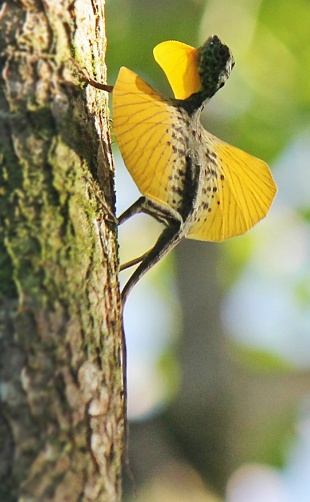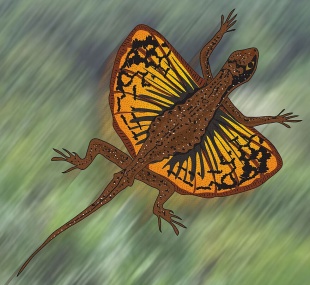FLYING LIZARDS
Several dozen related species of flying lizards — including Draco lizards — are found in Borneo, peninsular Malaysia, Southeast Asia, some of the islands in Indonesia, southern India and Australia. They generally glide from tree trunk to tree trunk like a flying squirrel and have the ability to loop around the tree for a better position. They are fairly common in forests, areca gardens, teak plantations and shrub jungle.
Forty-one species of Draco lizards are recognized, including
Singapore flying dragon (Draco abbreviatus)
Lazell's flying dragon (Draco biaro Lazell)
Two-spotted flying lizard (Draco bimaculatus)
Blanford's flying dragon (Draco blanfordii)
Crested flying dragon (Draco cristatellus)
Fringed flying dragon (Draco fimbriatus)
Dusky gliding lizard (Draco formosus)
Günther's flying lizard (Draco guentheri)
red-bearded flying dragon (Draco haematopogon)
Indochinese flying lizard (Draco indochinensis)
Lined flying dragon (Draco lineatus)
Spotted flying dragon (Draco maculatus)
Giant gliding lizard (Draco maximus)
Black-bearded gliding lizard (Draco melanopogon Boulenger)
Mindanao flying dragon (Draco mindanensis)
Lined flying dragon (Draco modiglianii)
Norvill's flying lizard (Draco norvillii)
Dusky gliding lizard (Draco obscurus)
white-spotted flying lizard (Draco ornatus)
Punctate flying dragon (Draco punctatus)
Quadras's flying lizard (Draco quadrasi)
Five-lined flying dragon (Draco quinquefasciatus)
Flying lizards are both nocturnal and diurnal varieties. They forage for ants and termites. Many species are quite territorial. If a rival arrives the resident lizard will quickly swoop down next it, launching into off aggressive displays — flicking out the triangular skin under the lizards’s chins — until the intrude leaves. In the mating season, males stake out territories and display their prominent dewlaps to attract females and scare off rival males. Sometimes males chase each other through the air and from tree to tree.
RELATED ARTICLES:
REPTILES: TAXONOMY, CHARACTERISTICS, THREATENED STATUS factsanddetails.com
LIZARDS: CHARACTERISTICS, SENSES, ODDITIES factsanddetails.com
GECKOS: CHARACTERISTICS, AMAZING FEET, WALKING ON WALLS factsanddetails.com
INTERESTING GECKOS IN SOUTH AND SOUTHEAST ASIA factsanddetails.com
Websites and Resources on Animals: Reptile Database reptile-database.org ; Reptileweb reptilesweb.com ; Reptile Phylogeny whozoo.org/herps/herpphylogeny ; Animal Diversity Web animaldiversity.org ; BBC Earth bbcearth.com; A-Z-Animals.com a-z-animals.com; Live Science Animals livescience.com; Animal Info animalinfo.org ; World Wildlife Fund (WWF) worldwildlife.org the world’s largest independent conservation body; National Geographic National Geographic ; Endangered Animals (IUCN Red List of Threatened Species) iucnredlist.org
Flying Lizards in Flight
Draco lizards are exclusively arboreal. They can can easily glide for over 30 meters (100 feet) and flit about from tree trunk to tree trunk and branch to branch using winglike lateral extensions of skin called patagia. They are not capable of powered flight but they often obtain lift in the course of their gliding flights. Glides as long as 60 meters (200 feet) have been recorded, over which the animal loses only 10 meter (33 feet) in height which makes for a glide ratio of 6:1.
Flying lizards create a gliding surface with skin stretched between the elongated false ribs on each side of their bodies. At rest these ribs are folded up against the body like wings. When they leap the ribs pulls forward, causing the false ribs to extend and the skin around them to open up like an umbrella. The gliding is used primarily as a way to get from places to place and quickly escape predators. It isn’t used so much to pursue prey. For that the crawl around like regular lizards although sometimes they will pounce on an insect that exposes itself within range of a quick flight. . Describing how the Draco flying lizard flies, David Attenborough wrote, " "It's ribs are hugely elongated. When the animals is sitting quietly on a branch, they lie close to its body, parallel to its spine on which they are hinged. When it jumps, its abdominal muscles contract, drawing the ribs forward so that they fan out and expose a wide flap of brightly colored kin on either side of the body."
Draco volans “fly” by climbing a tree and jumping. While jumping, they spread out their wings and glide. They glide for eight meters on average and easy to tell when they are going to fly — they turn their head so it pointing toward the ground. Gliding is only used as a way to get from place to place and not to escape predators. They generally don’t glide when it is raining or windy. To escape danger, the lizard climb up a tree. [Source: Michael Van Arsdale, Animal Diversity Web (ADW) /=]
Draco Volans
The most common flying lizard is the 22-centimeter (8.7-inch) -long “draco volans”. When at rest its greenish or greyish skin blends in well with the bark or leaves of trees. Some have bright orange patches on their flying membrane that only become exposed when they fly. The markings may scare or confuse predators. Males have a throat appendage or “fan” that is orange. Females have a fan that is blue.
Draco volans are commonly known as the common flying dragon or flying lizard. They are found in tropical rain forests and other places with an adequate number of trees for the lizard to jump from in southern India and Southeast Asia, including the Philippine islands and Borneo. They are very agile and, it is said, are very difficult to capture.[Source: Michael Van Arsdale, Animal Diversity Web (ADW) /=]
Draco volans are not threatened and seem to be fairly common and have adpted to human-disturbed environments although they need trees. On the International Union for Conservation of Nature (IUCN) Red List they are listed as Not Evaluated. They are small and not commonly eaten by humans. Draco volans are regarded as poisonous by many Philippine people but this does not appear to be true.
Draco Volans Characteristics and Diet
Draco volans are distinguished from other Draco lizards by the rows of rectangular brown spots on the top of the wing membranes, and black spots on the bottom of the wing. Males volans are around 19.5 centimeters (7.7 inches) in length while females are 21.2 centimeters (8.3 inches). This includes their long slender tail which is approximately 11.4 centimeters (4.5 inches) on males and 13.2 centimeters (5.2 inches) on females.
Draco volans has a large set of "wings" along the sides of the body, which are used for flight. These are supported by elongated ribs. They also have a gular flap called a dewlap, which is located under the head. This tissue is used during displays. The body is very depressed and elongated. The male Draco has a long pointed dewlap, which is bright yellow. They also have bluish color on the ventral side of the wings, and brown on the dorsal side. Females are slightly different in that the dewlap is smaller and bluish gray. Also, the ventral side of the wings is yellow.. /=\
Draco volans are generally insectivorous, feeding mostly on small ants and termites. They have been described as sit and wait feeders. They typically plant themselves on a tree tree trunk — not moving and well-camouflaged — waiting for an insect to pass within striking range. When an ant or termite is close enough, the lizard is able to snatch it without shifting its own body. /=\
Draco Volans Behavior
Draco volans are diurnal (active during the daytime). Males are generally more active then females during the day. Most males are very territorial (defend an area within the home range). The territories include two to three trees in which one to three females live, thus defining the lizards as residents. Males defend these territories from other males that do not have territories, or are considered non residents. [Source: Michael Van Arsdale, Animal Diversity Web (ADW) /=]
Draco volans are active from approximately 8:00am to 11:00am and again after 1:00pm into the afternoon. Between 11:00am and 1:00pm they take a break from normal activity. This is believed to allow the lizards to avoid the greatest light intensity during the day.
When the male Draco volans comes in contact with other Dracos or other lizard species, there are five behaviors that can be displayed: 1) partial extension of gular fold, 2) partial opening of wings, 3) bobbing of the body, 4) complete extension of the gular fold and wings, and 5) circling around the female. The first two displays are generally for other male species and are used to make their body appear bigger. The latter three displays are used to attract females.
Draco Volans Reproduction
Michael Van Arsdale wrote in Animal Diversity Web: It is not known exactly when reproduction occurs, but it is assumed to be in December and January. Males, and occasionally females, show several displays. These include the spreading of the wings and a bobbing motion of the entire body when the two are in close proximity to each other. [Source: Michael Van Arsdale, Animal Diversity Web (ADW) /=]
The male will also spread his dewlap to a fully erect position and then circle the female three times before copulation. The female will only show display patterns to stop or prevent copulation. The female Draco will build a nest for the eggs by forcing her head into the soil to create a small hole.
She will then lay five eggs into the hole and cover them with dirt, packing the soil on top of them with a patting motion of her head. For approximately twenty four hours, the female will guard the eggs fiercely. After this period, no further guarding occurs. Incubation of the eggs take approximately 32 days.
Image Sources: Wikimedia Commons
Text Sources: Animal Diversity Web animaldiversity.org ; National Geographic, Live Science, Natural History magazine, David Attenborough books, New York Times, Washington Post, Los Angeles Times, Smithsonian magazine, Discover magazine, The New Yorker, Time, Reuters, Associated Press, AFP, Lonely Planet Guides, CNN, BBC, Wikipedia, The Guardian, Top Secret Animal Attack Files website and various books and other publications.
Last updated February 2025


